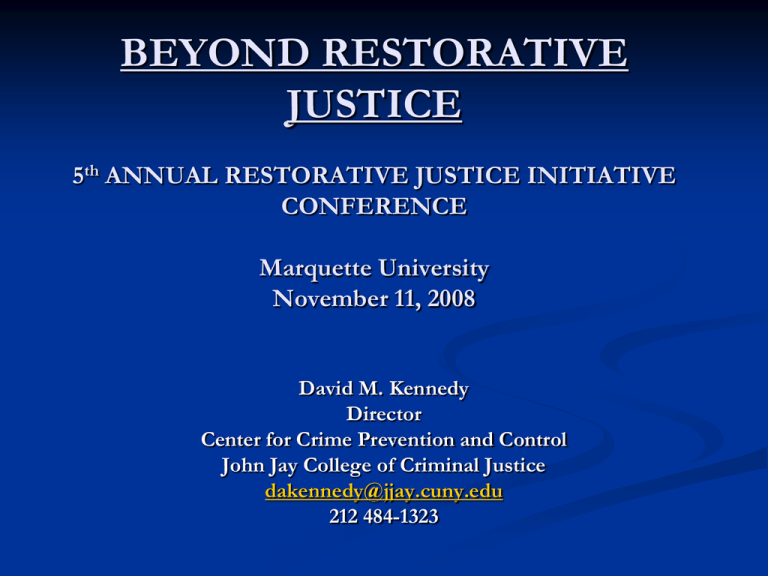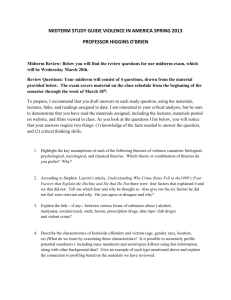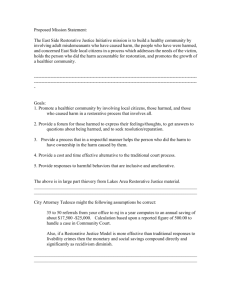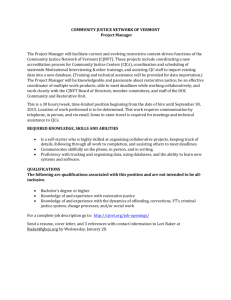BEYOND RESTORATIVE JUSTICE 5 ANNUAL RESTORATIVE JUSTICE INITIATIVE
advertisement

BEYOND RESTORATIVE JUSTICE 5th ANNUAL RESTORATIVE JUSTICE INITIATIVE CONFERENCE Marquette University November 11, 2008 David M. Kennedy Director Center for Crime Prevention and Control John Jay College of Criminal Justice dakennedy@jjay.cuny.edu 212 484-1323 RESTORATIVE JUSTICE Extraordinarily powerful and important ideas Unnecessarily and unconsciously limited by (usually) implicit framework If we take the strengths and discard the limits, we end up in a place that may be even more powerful and important RJ CRITIQUE OF CRIMINAL JUSTICE “Formal social control” Ineffective and damaging Doesn’t work as well as we’d like Overutilizes punishment: brutalizing Stigmatizes and excludes, often permanently Creates polarized “others” where there should be community “War on crime,” “war on drugs” Appropriates standing to state, disregards and weakens community FOR EXAMPLE Baltimore: 60% black males 16-30 under criminal justice supervision Lifetime chance of prison for black males 1:3 Crime down dramatically while prison population continues to grow Growth of “stop snitching” movement RJ ALTERNATIVE “Informal social control” Internal Shame Guilt Conscience External The views of those we care about Family Friends Loved ones Community INFORMAL SOCIAL CONTROL More powerful than formal social control Internal more powerful than external Operates without state Cops vs. grandmothers (Somewhat less true than sometimes thought) Operates more or less constantly Operates, usually, without permanent stigma and exclusion Can lead to “reintegration” RESTORATIVE JUSTICE The deliberate activation and mobilization of informal social control Techniques for activating shame, guilt, conscience Contact with victims Moral engagement Challenging competing norms and narratives Mobilization of personal and community networks to set and enforce norms, narratives, expectations RESTORATION AND RECONCILIATION Framing of offender as moral agent worthy of respect Engagement with family, peers, community Engagement with offender’s moral self Weakening negative connections, strengthening positive ones Central goal of keeping offender in community, or reestablishing legitimacy and standing Symbolic and actual reintegration FRAMED AS FREESTANDING ALTERNATIVE Extremely powerful and attractive set of ideas Couched from beginning in conscious opposition to existing criminal justice system and its weaknesses and harms Becomes in practice alternative case processing system, sidestepping criminal justice system, avoiding the damage it does and creating new benefits PROBLEMS WITH EXISTING RJ FRAMEWORK Unrealistic about actual role of coercive state power in restorative justice process Disregards moral standing of state Disregards state interest in public safety and in securing a monopoly on criminal enforcement Disregards role of sanction and deterrence in underpinning good behavior and positive norms and narratives PROBLEMS WITH ALTERNATIVE CASE PROCESSING FRAMEWORK Some cases not appropriate, even in principle, for classic restorative justice Domestic violence Some cases too serious Cannot accommodate need for incapacitation and/or formal punishment MORE PROBLEMS Handcuffs RJ to existing law and police practice RJ new “back end,” but state and police still “front end” Focuses on individual incidents and individual offenders Well-established critique from, for example, problem-oriented policing Fundamentally reactive No strategic focus No attention to underlying problems EXTREMELY POWERFUL IDEAS: VERY LIMITED APPLICATION In practice, ends up restricted to relatively minor incidents, mostly involving juveniles Sweeping critique and response; limited and lowlevel application Restorative justice has been hobbled by an unconscious attachment to traditional criminal justice and by framing itself as an alternative case processing system RJ IDEAS TOO IMPORTANT FOR THIS Drop “alternative case processing” framework Not about individual incidents and cases any longer Need not be about those under arrest Groups “Problems” Can accommodate serious offenses and offenders Can involve state authority and deterrence, formal sanction “FOCUSSED DETERRENCE” FRAMEWORK “Boston model,” “Ceasefire,” “High Point” Strategic intervention aimed at specific problems Group and gang violence Overt drug markets Three-pronged intervention Certain formal sanction: effective formal deterrence Help and services “Moral voice of community”: or restorative justice Going on in Milwaukee now, with Marquette: Safe Streets CIRV – Network Analysis of Street Sets Red – Beef Green – Alliance Blue – Volatile CRIMINAL HISTORIES OF CINCINNATI GROUP MEMBERS GROUPS IN CINCINNATI HOMICIDES VIOLENCE AS A GROUP/“STREET” DYNAMIC Much violence group-on-group “beefs” or vendettas Powerful peer effects: not just an individual decision. Street code: this is all OK, no alternatives, not my fault, don’t mind dying, prison’s not a problem, violence is required May not entirely believe this as individuals, but group dynamic dominates Seen as supported/tolerated by community: anger expressed at history, police, whites Why community “moral voice” so important MANY KEY PLAYERS KNOWN, EVEN WHEN NOT LEGALLY AVAILABLE Legal system needs legal predicate Other ways of intervening do not RJ framework can often be applied CONSEQUENCES Group accountability for homicide: group dynamic, group sanction Last resort Explained ahead of time By any legal means: “pulling levers” Most serious sanctions on impact players Careful promise: sanction on next homicide; on most violent group Reversal of pro-violence peer pressure “Honorable exit” HELP Focused services Employment Education Treatment Mentoring Others “COMMUNITY MORAL VOICE”: RJ IN A DIFFERENT SETTING Clear, direct, community stand Figures respected by offenders Parents Ministers, mothers, activists Offenders and ex-offenders Set community norms Make offenders own what they do Challenge street code Love the sinner but hate the sin: bring them back in MORAL VOICE, CONT. Set community standard “There is no excuse.” “We need you, you’re better than this.” Moral engagement “Who thinks it’s OK for little kids to get shot?” “Do you want your mother standing here?” Challenge street code/norms “Shot any CIA agents lately?” “Who helped your mother last time you were locked up?” “Do you think your friends won’t flip on you?” Group Member Involved (GMI) Homicides in Cincinnati July 2006 - March 2008 9 Call-in sessions 10/03 8 Call-in sessions 7/31 7 # of homicides 6 5 4 3 2 1 0 Jul06 Aug06 Sep06 Oct06 Nov06 Dec06 Jan07 Feb07 Mar07 Apr07 May07 Likely GMI Homicide Jun07 Jul07 Aug07 Sep07 Non-GMI Homicide Oct07 Nov07 Dec07 Jan08 Feb08 Mar08 “HIGH POINT” STRATEGY Closes overt community drug markets Explicitly addresses racial conflict and unintended harms from ordinary drug enforcement Involves dealers’ families much more effectively than gang strategy: large lessons here Closed market largely sustained by new community standards OTHER EXAMPLES Street robberies Domestic violence Prison issues ?? SO: RESTORATIVE JUSTICE Is an even bigger set of ideas than many advocates suspect Works with serious offenders Can be adapted to core underlying problems Need not wait for police or state to act Need not focus on alternative case processing Engages – very effectively – with community standards and serious offenders’ consciences Can fit seamlessly with formal social control TRANSFORMATIVE POSSIBILITIES Greatly increase public safety Address racial conflict Reduce incarceration Strengthen communities Substitute deterrence for enforcement Create pathways for seasoned offenders





